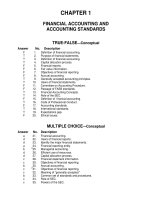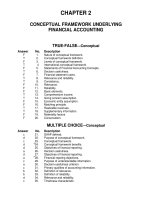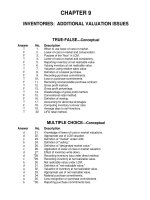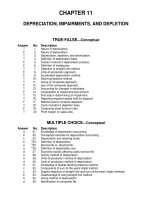Intermediate accounting 16e by kieso slide ch08
Bạn đang xem bản rút gọn của tài liệu. Xem và tải ngay bản đầy đủ của tài liệu tại đây (2.39 MB, 70 trang )
8-1
PREVIEW OF CHAPTER 8
Intermediate Accounting
16th Edition
Kieso ● Weygandt ● Warfield
8-2
8
Valuation of Inventories:
A Cost-Basis Approach
LEARNING OBJECTIVES
After studying this chapter, you should be able to:
1 Understand inventory
classifications and different
inventory systems.
2 Determine the goods and costs
included in inventory.
4 Identify special issues related to
LIFO.
5 Determine the effects of
inventory errors on the financial
statements.
3 Describe and compare the cost
flow assumptions used to
account for inventories.
8-3
LO 1
INVENTORY ISSUES
Classification
Inventories are asset:
items held for sale in the ordinary course of business, or
goods to be used in the production of goods to be sold.
Businesses with Inventory
Merchandiser
8-4
or
Manufacturer
LO 1
INVENTORY ISSUES
Classification
One inventory
account.
Purchase
merchandise in
a form ready for
sale.
ILLUSTRATION 8-1
Comparison of Presentation
of Current Assets for
Merchandising and
Manufacturing Companies
8-5
LO 1
INVENTORY ISSUES
Classification
Three accounts
Raw Materials
Work in Process
Finished Goods
ILLUSTRATION 8-1
Comparison of Presentation
of Current Assets for
Merchandising and
Manufacturing Companies
8-6
LO 1
ILLUSTRATION 8-2
Flow of Costs through
Manufacturing and
Merchandising Companies
8-7
LO 1
INVENTORY ISSUES
Inventory Cost Flow
ILLUSTRATION 8-3
Inventory Cost Flow
Two types of systems for maintaining inventory records — perpetual
system or periodic system.
8-8
LO 1
Inventory Cost Flow
Perpetual System
1. Purchases of merchandise are debited to Inventory.
2. Freight-in is debited to Inventory. Purchase returns and
allowances and purchase discounts are credited to
Inventory.
3. Cost of goods sold is debited and Inventory is credited for
each sale.
4. Subsidiary records show quantity and cost of each type of
inventory on hand.
The perpetual inventory system provides a continuous
record of Inventory and Cost of Goods Sold.
8-9
LO 1
Inventory Cost Flow
Periodic System
1. Purchases of merchandise are debited to Purchases.
2. Ending Inventory determined by physical count.
3. Calculation of Cost of Goods Sold:
Beginning inventory $ 100,000
Purchases, net + 800,000
Goods available for sale900,000
Ending inventory
- 125,000
Cost of goods sold $ 775,000
8-10
LO 1
Inventory Cost Flow
Comparing Perpetual and Periodic System
Illustration: Fesmire Company had the following transactions
during the current year.
Record these transactions using the Perpetual and Periodic
systems.
8-11
LO 1
Inventory Cost Flow
8-12
ILLUSTRATION 8-4
Comparative Entries—
Perpetual vs. Periodic
LO 1
Inventory Cost Flow
Illustration: Assume that at the end of the reporting period, the
perpetual inventory account reported an inventory balance of
$4,000. However, a physical count indicates inventory of $3,800 is
actually on hand. The entry to record the necessary write-down is
as follows.
Inventory Over and Short 200
Inventory
200
Note: Inventory Over and Short adjusts Cost of Goods Sold. In practice, companies
sometimes report Inventory Over and Short in the “Other revenues and gains” or
“Other expenses and losses” section of the income statement.
8-13
LO 1
INVENTORY ISSUES
Inventory Control
All companies need periodic verification of the inventory records
by actual count, weight, or measurement,
with counts compared with detailed inventory records.
Companies should take the physical inventory
8-14
near the end of their fiscal year,
to properly report inventory quantities in their annual
accounting reports.
LO 1
WHAT DO THE NUMBERS MEAN?
LEAN
WHAT’S YOURSTAYING
PRINCIPLE
When you drop by a Walmart store, you are witnessing one of history’s
greatest logistical and operational successes. As one article noted, the
retail giant stocks products in more than 70 countries and at any given
time operates more than 11,000 stores in 27 countries around the world. It
manages an average of $32 billion in inventory.
With these kinds of numbers, having an effective and efficient supply chain
management system and a sound internal control system is imperative.
For example, Walmart Stores, Inc. uses its buying power in the supply
chain to purchase an increasing proportion of its goods directly from
manufacturers and on a combined basis across geographic borders.
Walmart estimates that it saves 5–15% across its supply chain by
implementing direct purchasing on a combined basis for the 15 countries
in which it operates. Thus, Wal-Mart has a good handle on what products it
needs to stock, and it gets the best prices when it purchases.
Walmart also provides a classic example of the use of tight inventory
8-15
(continued)
LO 1
WHAT DO THE NUMBERS MEAN?
LEAN
WHAT’S YOURSTAYING
PRINCIPLE
controls. Department managers use a scanner that when placed over the
bar code corresponding to a particular item, will tell them how many of the
items the store sold yesterday, last week, and over the same period last
year. It will tell them how many of those items are in stock, how many are
on the way, and how many the neighboring Walmart stores are carrying (in
case one store runs out). Walmart’s inventory management practices have
helped it become one of the top-ranked companies on the Fortune 500 in
terms of sales.
Sources: J. Birchall, “Walmart Aims to Cut Supply Chain Cost,” Financial Times (January
4, 2010); and />
8-16
LO 1
INVENTORY ISSUES
Determining Cost of Goods Sold
Companies must allocate the cost of all the goods available for
sale (or use) between the goods that were sold or used and
those that are still on hand.
ILLUSTRATION 8-5
Computation of Cost of Goods Sold
8-17
LO 1
8
Valuation of Inventories:
A Cost-Basis Approach
LEARNING OBJECTIVES
After studying this chapter, you should be able to:
1 Understand inventory
classifications and different
inventory systems.
2 Determine the goods and costs
included in inventory.
4 Identify special issues related to
LIFO.
5 Determine the effects of
inventory errors on the financial
statements.
3 Describe and compare the cost
flow assumptions used to
account for inventories.
8-18
LO 2
GOODS AND COSTS INCLUDED IN
INVENTORY
Goods Included in Inventory
A company recognizes inventory and accounts payable at
the time it controls the asset.
Passage of title is often used to determine control because
the rights and obligations are established legally.
8-19
LO 2
Goods Included in Inventory
Goods in Transit
Ownership of the goods passes
to the buyer when the public
carrier accepts the goods from
the seller.
8-20
Ownership of the goods remains
with the seller until the goods
reach the buyer.
LO 2
Goods Included in Inventory
Consigned Goods
8-21
Goods out on consignment remain the property of the
consignor.
The consignee makes no entry to the inventory account for
goods received.
LO 2
Goods Included in Inventory
Special Sales Agreements
Sales with Repurchase Agreement.
Often referred to as a repurchase (or product financing)
agreement, usually involves a transfer (sale) with either an
implicit or explicit repurchase agreement.
These arrangements are often described in practice as
“parking transactions.”
UNDERLYING CONCEPTS
Recognizing revenue at the time the inventory is “parked” violates the
revenue recognition principle. That is, a performance obligation is not
met because control has not been transferred to the buyer.
8-22
LO 2
Goods Included in Inventory
Special Sales Agreements
Sales with High Rates of Return.
Seller
1. Record sales revenue at the amount it expects to receive
from the transaction.
2. Establishes an estimated inventory return account at the
date of sale to recognize that some of its inventory will be
returned.
8-23
LO 2
WHAT DO THE NUMBERS MEAN?
8-24
NO PARKING!
WHAT’S YOUR PRINCIPLE
In one of the more elaborate accounting frauds, employees at Kurzweil
Applied Intelligence Inc. booked millions of dollars in phony inventory
sales during a two-year period that straddled two audits and an initial
public stock offering. They dummied up phony shipping documents and
logbooks to support bogus sales transactions. Then they shipped hightech equipment, not to customers, but to a public warehouse for
“temporary” storage, where some of it sat for 17 months. (Kurzweil still had
ownership.)
To foil auditors’ attempts to verify the existence of the inventory, Kurzweil
employees moved the goods from warehouse to warehouse. To cover the
fraudulently recorded sales transactions as auditors closed in, the
employees brought back the still-hidden goods, under the pretense that
the goods were returned by customers. When auditors uncovered the
fraud, the bottom dropped out of Kurzweil’s stock. Similar inventory
shenanigans occurred at Delphi, which used side-deals with third parties
to get inventory off its books and to record sales. The overstatement in
income eventually led to a bankruptcy filing for Delphi. More recently and
(continued)
LO 2
WHAT DO THE NUMBERS MEAN?
NO PARKING!
WHAT’S YOUR PRINCIPLE
with an international twist, concerns about inventory shenanigans are
surfacing in China. Following years of torrid growth, the global economic
slowdown has resulted in a huge buildup of unsold goods that is cluttering
shop floors, clogging car dealerships, and filling factory warehouses. The
large inventory overhang is raising alarms about phantom profits and
suspect economic data coming out of China.
Sources: Adapted from “Anatomy of a Fraud,” BusinessWeek (September 16, 1996), pp.
90–94; J. McCracken, “Delphi Executives Named in Suit over Inventory Practices,” Wall
Street Journal (May 5, 2005), p. A3; and K. Bradsher, “China Confronts Mounting Piles of
Unsold Goods,” The New York Times (August 23, 2012).
8-25
LO 2









